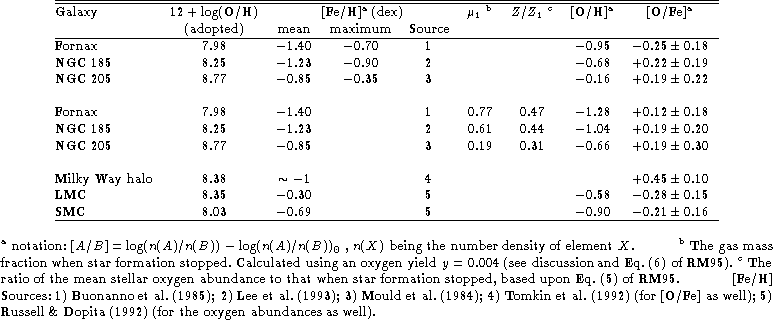

Up: Theoretical models of
RM95 used the mean oxygen abundances for the
planetary nebulae in NGC 185, NGC 205, and Fornax to investigate
whether diffuse elliptical galaxies are related to dwarf irregulars
by evolution. If dwarf irregulars evolve to become diffuse
ellipticals, star formation in dwarf irregulars must cease,
requiring dwarf irregulars to fade in the process. Consequently, if
they are the faded remnants of dwarf irregulars, diffuse ellipticals
must have higher oxygen abundances than similarly luminous dwarf
irregulars. RM95 found that diffuse ellipticals did have
systematically higher oxygen abundances than similarly luminous
dwarf irregulars, but that diffuse ellipticals also had higher
[O/Fe] ratios than dwarf irregulars of the same oxygen abundance.
While the oxygen abundances alone allow that dwarf irregulars fade
to become diffuse ellipticals, the [O/Fe] ratios indicate that this
is unlikely. Since oxygen is produced by type II supernovae, the
interstellar medium is enriched in oxygen much more rapidly than it
is in iron, to whose production much longer-lived type Ia supernovae
contribute significantly. Thus, the [O/Fe] ratio is a measure of
the rate at which a galaxy consumes its gas. The higher [O/Fe]
ratios in diffuse ellipticals indicate that they consumed their gas
more rapidly than dwarf irregulars. Here, we consider the effect of
abundance gaps on these conclusions.
The mean oxygen abundances for
the planetary nebula populations in NGC 185, NGC 205, and Fornax
studied by RM95 are listed in Table 5 (click here). Since these mean
abundances are for all planetary nebulae up to 2 mag below the PNLF
peak, we computed abundance gaps using the numbers and abundances
for planetary nebulae up to 2 mag below the PNLF peak for the RX
and FX series in Table 4 (click here):

The oxygen abundances in the
interstellar medium for NGC 185 and NGC 205 in Table 5 (click here)
were obtained by solving Eq. (17), given the adopted mean oxygen
abundances for the planetary nebulae. Since there is only one
known planetary nebula in Fornax, we chose not to make an
abundance gap correction. The interstellar medium oxygen
abundances in Table 5 (click here) are those predicted to persist when
star formation stopped. In Fig. 7 (click here), we compare the
predicted last epoch abundances for NGC 185, NGC 205, and Fornax
with the metallicity-luminosity relation for dwarf irregulars
presented by RM95. Including the effect of the abundance gap for
the diffuse ellipticals increases the discrepancy between their
oxygen abundances and those of similarly luminous dwarf irregulars.

Figure 7: The metallicity-luminosity relations for dwarf galaxies. The oxygen abundances
plotted for the diffuse ellipticals include a correction for the abundance gap (Eq. 17).
The line is a linear least squares fit to the dwarf irregulars with  (see RM95)
(see RM95)

Table 5: Mean oxygen abundances
Table 6 (click here)
presents our revised [O/Fe] ratios for the diffuse ellipticals.
Table 6 (click here) is identical to Table 6 (click here) of RM95 except
for the oxygen abundances adopted for the diffuse ellipticals,
which are the last epoch abundances from Table 5 (click here). RM95
present an extensive discussion of the derivation of the [O/Fe]
ratios for the diffuse ellipticals in Table 6 (click here), to which we
refer the reader for details. Briefly, the first set of [O/Fe]
ratios is based upon the maximum [Fe/H] and [O/H] ratios for the
stellar population, while the second set is based upon the mean
[Fe/H] and [O/H] ratios. We derived the first set of [O/Fe]
ratios by modifying the mean iron abundances using the [Fe/H]
dispersions, whereas we derived the second set by modifying the
oxygen abundances using chemical evolution models. The sources of
error are discussed in RM95. In Fig. 8 (click here), we plot the
[O/Fe] ratios for the galaxies as a function of the oxygen
abundance in the interstellar medium. The diffuse ellipticals
still have systematically higher [O/Fe] ratios than dwarf
irregulars.

Figure 8: Comparison of the [O/Fe] ratios for diffuse ellipticals with those for the
Magellanic Clouds and the Milky Way halo. For the diffuse ellipticals, the filled
symbols denote the [O/Fe] ratios computed from the closed box model of chemical
evolution, while the open symbols denote [O/Fe] ratios derived from the maximum iron
abundance. (For NGC 205, the [O/Fe] ratios from both methods are identical). The
horizontal line indicates the solar [O/Fe] ratio. The error bars include the uncertainties
in the oxygen and iron abundances, and, for the diffuse ellipticals, the effect of allowing
the yield of oxygen to vary between 0.002 and 0.02. For clarity, the error bars for the
diffuse ellipticals are shifted slightly to the right of the closed box [O/Fe] ratios

Table 6: [O/Fe] in diffuse ellipticals
In
summary, including the effect of the abundance gap in estimating the
interstellar medium oxygen abundances in diffuse ellipticals
strengthens the conclusions of RM95. When star formation stopped in
diffuse ellipticals, their interstellar medium oxygen abundances
were systematically higher than those observed today in similarly
luminous dwarf irregulars, and their [O/Fe] ratios were
systematically higher than those observed in dwarf irregulars with
the same oxygen abundance. The simplest explanation for both of
these observations is that diffuse ellipticals formed their stars on
shorter time scales than dwarf irregulars. Therefore, given their
different star formation histories, diffuse ellipticals cannot be
the faded remnants of dwarf irregulars.


Up: Theoretical models of
Copyright by the European Southern Observatory (ESO)
web@ed-phys.fr


